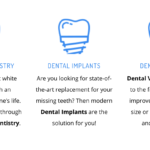In the realm of healthcare, affordability remains a pressing concern for individuals across the globe. While access to medical services is a fundamental right, the dental sector often finds itself overlooked in discussions surrounding healthcare accessibility. Dental care is not merely about aesthetics; it’s integral to overall health and well-being. However, the soaring costs associated with dental treatments have left many struggling to afford essential care. In this context, the role of government in bridging the affordability gap in dentistry warrants scrutiny.
The foundation of effective dental care lies in preventive measures. Regular check-ups, cleanings, and early interventions can significantly mitigate the need for costly treatments down the line. Yet, for a considerable portion of the population, even routine dental visits pose a financial burden. The cost of living is steadily rising, making it increasingly difficult for individuals and families to prioritize dental care amidst other essential expenses.
One avenue through which individuals can navigate the complexities of dental costs is by engaging with their local dentists. Establishing a relationship with a trusted local dentist can provide insights into available options for affordable care. Too often, people are unaware of potential discounts, payment plans, or community resources that could alleviate the financial strain of dental treatments. Hence, it’s essential to encourage individuals to proactively inquire about such possibilities.
When faced with the dilemma of affordability, many individuals hesitate to seek dental care, opting instead to postpone or neglect treatment altogether. This reluctance can exacerbate oral health issues, leading to more extensive and expensive procedures down the road. Therefore, empowering individuals to ask your local dentist near you about cost-effective solutions is paramount in ensuring timely and adequate care.
However, the responsibility of addressing affordability in dentistry cannot rest solely on the shoulders of individual practitioners. Governments play a pivotal role in shaping healthcare policies and allocating resources to meet the needs of their citizens. Despite this, the extent to which governments address the affordability gap in dental care varies significantly across regions.
In some countries, government-funded healthcare programs include dental services as part of their coverage, ensuring that basic dental needs are met for all citizens. However, the scope of these services may be limited, often covering only essential procedures while leaving more specialized treatments beyond the reach of many. Moreover, long waiting times and bureaucratic hurdles can deter individuals from accessing these services in a timely manner.
In contrast, other nations lack comprehensive dental coverage within their public healthcare systems, leaving individuals to fend for themselves in navigating the complexities of private dental care. This disparity in access underscores the need for governments to reassess their approach to dental healthcare and prioritize affordability as a core component of overall public health initiatives.
The issue of affordability in dentistry extends beyond national borders, encompassing a global landscape where socioeconomic disparities intersect with systemic shortcomings in healthcare infrastructure. In low-income countries, access to even basic dental care can be scarce, with limited resources allocated to oral health services amidst competing healthcare priorities. As a result, preventable oral health conditions persist, contributing to a cycle of poverty and poor health outcomes.
Addressing the affordability gap in dentistry requires a multifaceted approach that combines individual empowerment, government intervention, and international cooperation. Local dentists can play a vital role in advocating for their patients’ needs and facilitating access to affordable care within their communities. Likewise, governments must recognize dental health as integral to overall well-being and allocate sufficient resources to ensure universal access to quality dental services.
In conclusion, the cost of living is killing people, making dental care increasingly inaccessible for many. While local dentists can provide valuable guidance on navigating affordability issues, the onus ultimately falls on governments to prioritize dental health as a public health imperative. By working collaboratively to address the affordability gap in dentistry, we can ensure that everyone has the opportunity to maintain optimal oral health and overall well-being, regardless of their socioeconomic status.








